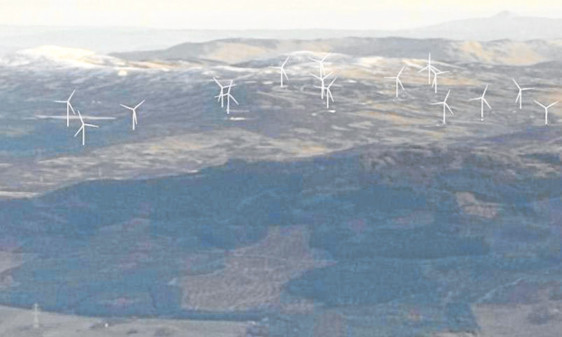Perth and Kinross Council has been ordered to pay up after Scottish ministers ruled it acted “unreasonably” and bowed to public pressure when it blocked plans for a highly controversial windfarm expansion.
Multi-million-pound plans for a new seven-turbine development at North Calliacher, one of Scotland’s biggest windfarm sites, were rejected by councillors in the face of widespread opposition last year.
Perth-based I&H Brown has now successfully forced the council to reverse its decision, following an appeal to the Scottish Government.
In its findings, the Directorate for Planning and Environmental Appeals (DPEA) criticised the council for acting unreasonably, claiming councillors had been “unduly influenced” by objectors.
The council has now been told it is liable to pay I&H Brown’s appeal costs, which are believed to run into tens of thousands of pounds.
Windfarm campaigners said the appeal sector’s ruling had set a “dangerous precedent” for future large-scale developments and described it as a “slap in the face for local democracy”.
The project involves an expansion of the 14-turbine Calliacher development, near Amulree, which was swung into place in 2013 next to the 68-mast Griffin site.
Opponents called for the plan to be scrapped, arguing there was an “over-development” of turbines at the beauty spot.
The plan was knocked back by members of the development management committee last summer.
They argued it would have a negative impact on the local landscape.
In his report, DPEA reporter Dan Jackman said the council had provided “little evidence” to back up its reasons for refusal.
“The council’s appeal statement invited me to attach weight to the feelings expressed in the letters of representation, without explaining the planning harm,” he said.
“I conclude that the council has acted unreasonably.
“It has been unable to support its reasons for refusal and has been unduly influenced by local opposition, with insufficient assessment of the planning merits of the case.”
He said the council’s “unreasonable behaviour” had resulted in I&H Brown having to pay to take the matter to appeal.
A spokesman for the company said: “It is over two years since we applied for planning permission to develop North Calliachar.
“The actions of Perth and Kinross Council in refusing the original application are hard to comprehend and we take some small satisfaction in being awarded expenses against the council who were found to have acted unreasonably.
“This will allow us to partially recover the costs of the appeal.”
A council spokeswoman said it was “disappointed” with Mr Jackman’s ruling and said the terms of his decision would be considered carefully.
Scotland Against Spin (SAS), a national group which campaigns for Scottish energy policy reform, also condemned the findings.
Chairman Graham Lang said the decision was a “slap in the face for local democracy, reinforced by a slap to the council’s wallet”.
“We have seen a reporter attacking a council for giving weight to objection letters,” he said.
“Such letters are evidence in themselves and so long as they are based on planning grounds they must be considered something it would appear the reporter has not done.
“It is not up to the council to explain or assess the planning harm, that’s the reporter’s job. To say that elected members were ‘unduly influenced’ by local opposition is an insult to the committee.”
Helen McDade, head of policy at conservation group the John Muir Trust, said: “This is a disturbing decision that has serious implications for local democracy and for the spectacular landscapes of Highland. Anyone who values local democracy will be concerned that a single unelected individual can overturn a decision by elected councillors, despite the appeal process not offering these councillors and the wider public the opportunity to give oral evidence explaining their decision.”Local reactionResidents andcommunity groups who mobilised to fightthe North Calliacher development yesterday spoke of their disappointment at the ScottishGovernment’s ruling.
“So much for local democracy,” said Nan Johnstone, who chairs Dunkeld and Birnam Community Council.
“While it was frustrating that the planning officer recommended the North Calliacherapplication for approval, at least representatives had the opportunity to have their say at thedevelopment control committee.
“Local people believe the 84 turbines already in existence are more than enough and therefore the cumulative effects ofcreating a furtherindustrial landscape of seven turbines should be more pertinent tothe decision-makingprocess.
“But it would appear Mr Jackman hasdismissed the relevant arguments put forward by local residents,Dunkeld and Birnam Community Council and the John Muir Trust, to name but a few.”
She said a public inquiry should havebeen held. “It is extremely disappointing thatthe aforementionedparties were denied an opportunity to give oral evidence that may have resulted in a differentoutcome.”
She added: “It is astounding that thedeveloper is now going to be awarded costs.It appears that local residents are beingpenalised for trying to protect their environment from industrialisation.”
Susan MacKinnon said: “I felt I spent quitea lot of time readingthe documents andputting my arguments forward, as did a lotof people and to someat quite an expense, butto be denied the nextstage of the planningprocess seemed totally unjust and felt likewe were being ignored.”
